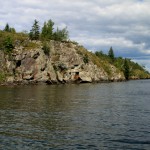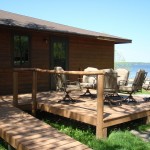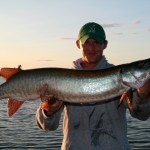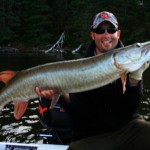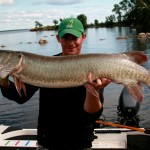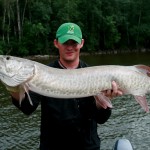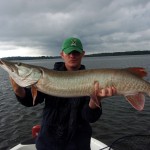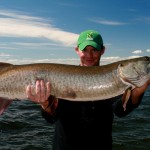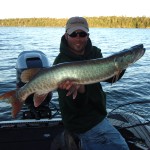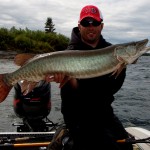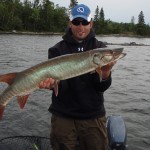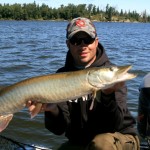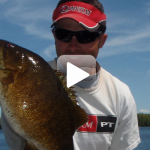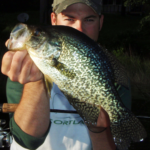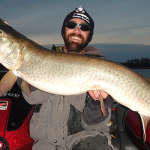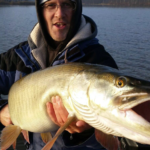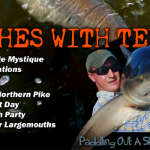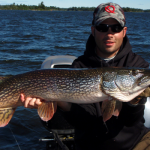Lake of the Woods, a million acre freshwater sea bordering the United States and Canada, boasts a muskellunge fishery that is among North America’s best. Fishing-Headquarters Magazine takes you on a pictorial journey, through the eyes of a Canon DSLR camera lens, that any serious angler should add to the lifetime bucketlist for muskie trips and getaways. Visualize it now, and we hope you can experience it like this sometime next year.
“I think I should reconsider this first week of August trip!” exclaimed my expert musky friend and boat captain, Brian Malack after complaining about the unproductive fishing experienced at this time a year ago. After all, he had just experienced a career afternoon on August 4th, 2013 with a trio of 50, 48.5, and 47.5 inch muskies that fell into the bag of my Frabill Conservation series net. “Thanks for providing all of today’s entertainment. It’s been a blast being your net man and filming all of this. I couldn’t agree more!” I concluded.
As most anglers are aware, muskies are the fish of ten thousand casts. It takes up to a full day for some of the very best in our game to connect with the elusive, opportunistic feeding predator. However, it happened to us quicker than imagined in less than 3 hours. After a rough season, Lake of the Woods, along with many other waterbodies in the northern muskellunge range have treated many anglers whom I personally know with an unkind attitude and scrooge-like characteristics. A one-of-a-kind day as experienced by Malack can quickly change one’s angling perspective and mentality.
Muskie fishing is 10 percent catching and 90 percent mental. The 21 fish trip we had can positively adjust the mindsets of a muskie fishing tandem. Thanks to this trip, which was undoubtedly the highlight to both of our fishing seasons, Malack and Ragas will be back again next year.

The Trip
For the second consecutive season, I was picked up by Malack’s F150 with Ranger boat in tow and departed from my home base in Northern Wisconsin for a week of fishing on Lake of the Woods. From August 2 through 10, 2013, our home for the week was Flag Island Resort, located at the Northwest Angle of the lake in the northernmost tip of the continental United States in Minnesota.
Operated and managed by Dan Schmidt, Flag Island Resort is an affordable trip that doesn’t cost an arm and a leg like most premier fishing getwaways do. They offer everything from cabin rentals, boat rentals, guides and outfitters, dock and boat services, meals, wifi and many more convenient accommodations. The remote location provides serious anglers and outdoorsmen with a convenient location, and a world of endless water, greenery, abundant wildlife and many sought-after gamefish species.
To get there, you need to travel through Northcentral Minnesota to the south shores of Lake of the Woods. Pass through the towns of Baudette and Warroad on Rte. 11 where you will then be greeted by border patrol and agents at the Canadian Port of Entry. Have your U.S. passports handy with a smile on your face. When granted access into Canuck Country, take Rte. 12 through Southeast Manitoba into the town of Sprague, cut around the lake on 308, and follow the signs to Angle Inlet, Minnesota. Drop the boat into Youngs Bay, park the vehicle on the mainland for a week, and transport yourselves across water to the resort for your entire week’s trip.
The Northwest Angle is the most fertile region of the lake, containing a combination of fast-warming shallower waters and weedy habitats along with deeper basins. The darker, shallower waters of the Angle allow for longer growing seasons, abundant forage and diverse sport fisheries. Fish species that can be enjoyed in the Northwest Angle are muskies, pike, walleyes, smallmouth bass, perch, crappies, whitefish and lake trout.
A typical day of muskie fishing on Lake of the Woods begins whenever you choose to set the bedside alarm and wake up. On most days, we’d have our morning coffee and group meal around 9am, and enjoy discussing and analyzing each boat’s strategies. Usually by 10am, we’d be out on the water and fishing our first of many spots for the day. Due to size and acreage (950,000 acres), it takes a while for the lake’s water temperatures to warm and peak for the day following cool nights. It also takes a bit of warmth to get muskies moving and on the feed as most productive hours tend to be anytime from 12 noon until dark. Therefore, and in our experience, it’s best to get a good night’s sleep and begin the day later in the morning as daily water temperatures usually don’t peak until the afternoon hours.

Due to its convenient location, many of our favorite fishing regions are located within a 40 minute boat ride from Flag Island. Visiting anglers tend to fish the basins of the nearby Windigo Islands, Bishops Bay and Big Narrows which is about 15 to 30 minutes north. Meanwhile, die-hards, aggressive anglers, and gas burners like us may elect to take longer runs and go farther north or east into the lake’s more remote locations, or south into the big wide open waters of Whitefish Bay.
On this trip, Malack and I filled up his Ranger 619vs to the maximum each morning with $5/gal as we’d effortlessly burn through 14-20 gallons on his 2 stroke 200 horse Yamaha Vmax. We ended up fishing almost everywhere and venturing off in every direction within a 30 to 40 mile radius around camp. The cumulative gas bill for the week was a staggering number, but the amount of muskies we encountered and caught along the way of each daily run made the painful aftermath to our bank accounts worthwhile.

The Fishing
As Malack and I are Cortland Line wielding anglers, 99% of this trip was dedicated to running and gunning for muskies while the remaining 1% went toward jigging for walleyes and the sustenance of shore lunch. Along the way, we were greeted by dozens of other vicious toothies which included aggressive and abundant 30 to 40+ inch northern pike that were strangely occupying the same spots we were locating our muskies.



In 7 ½ days of casting we enjoyed one 6 fish day, and another 5 fish day. Along the way and in between our numbers, we endured two days of getting shut-out. That’s musky fishing for you. The mid-week futility that we experienced can be attributed to the coldfront. However, the two and a half days before and after the coldfront hit the fishing was fantastic, as six fish in the range of 46 to 50 inches were caught.
Location is the most important component to muskie fishing. Lake of the Woods is full of muskie-holding areas and they all look good. But here’s the problem: only a few of these areas will consistently produce big fish or any at all. Because of this, it’s best to run and gun on Lake of the Woods, and cover as many spots as possible. Due to its acreage and thousands of islands, covering water on LOTW is a daunting task. There is only so much water and acreage that can be covered per day. However, by breaking down the lake into small sections and sticking with them, then revisiting productive spots you’ve found, and expanding your range from there makes it possible to fish as many as 30 to 40 spots per day which is what we had to do in order to contact fish.
Because LOTW is loaded with an infinite amount of spots that have the possibilities of all containing muskies, certain areas stand out to us more than others. Generally, we look for the following areas to help narrow down the choices for best time management:
- Large complexes that contain several smaller spots within (think of the term “spot on a spot”). On our big fish areas for this trip, many of the spots were sizeable rock reefs and fingers extending from islands, containing a combination of weeds or transitions to different bottom substrates such as sand. If it contained saddles, fish were almost always present.
- Weedy areas or shallow open pockets near large areas of open water. This is a trick we’ve learned from fishing with Doug Johnson and it’s something we usually keep in mind. Big fish like big water, and bays exposed to deep open water are big fish magnets. Sandy bays and pockets baking in sunlight that contain shallow vegetation deep inside of them were visited often and usually held muskies. These spots were our best producers as a pair of 48 inchers and a number of smaller fish were caught.
- Cabbage – sparse beds and not the thick walled ones: Rusty crayfish have decimated about 99% of Lake of the Woods weedgrowth and it has become a huge cause for concern. Any remaining cabbage beds and “sexual” weeds are high on the list and rare to find, as they attract prey fish followed by muskies. Junkweed is good too, especially in coldfront conditions. I caught a four footer sitting in shallow junkweed during the midst of one coldfront.
- Island complexes near deep open water, and steep drop-offs.
- Windblown rock points and island fingers.
- Reed beds that give way to depth and rock substrate.
- Random tip: Any stars or asterisk icons on your GPS units are always worth checking out for a quick cast, as these are rock hazards and large boulder fields

In Malack’s case, the biggest advantage of being granted the luxury of precious vacation time away from Chicago and fishing LOTW an average of 30 days per year gives him the opportunity to fish many spots like these over and over again. This allows him to pattern fish throughout the summer months, and practice the necessary time management skills for adequately fishing and working each spot. Unless fish are present, 10 to 15 minutes will usually be granted for a typical spot that is either new or has produced fish before. However, spots that have active fish, or multiples of them, will be camped on for up to 30-40 minutes at a time. On days I managed the boat control, I elected to camp out on a few spots neither of us had ever fished before and this decision resulted in catching two of our largest fish of the week.


In many Canadian waters such as Lake of the Woods, there are many presentations that muskies and other fish have not been yet subjected to. Like every body of water I’ve fished, there are a few techniques and presentations that stand out, and anglers use and continually produce with them. Additionally, with some experimentation, there are also many techniques just as effective that are haven’t been tried and aren’t yet mainstream.
As we know, different weather conditions, fish locations, and habitats dictate lure selections. Experienced Lake of the Woods muskie anglers like Malack have an LOTW go-to lure. It is the standby black and nickel bucktail. Fished extensively throughout the week before getting destroyed by muskies and banging over rocks, the Jr. Double Cowgirl by Musky Mayhem Tackle was the #1 producer of big fish for the week. Additionally, downsized throwback lures such as black & nickel Musky Mayhem Showgirls and Shumway Flashers connected with fish too.

The Jr. Double Cowgirl features two size 9 magnum blades and produces increased vibration at a slimmed down size for muskies to feel. Malack’s winning combination for the week was a 9 foot St. Croix Legend Tournament Big & Nasty rod, and the big blades were burned back to boatside with a Shimano Trankx reel spooled with 80lb Cortland Spectron. We both theorize that the bait was the perfect size and retrieved at the proper consistently fast speed that triggered both reactionary and figure 8 strikes. The length of rod also aided in boatside strikes with the figure-8 technique as all of Malack’s strikes occurred at least two feet below surface where he said “They couldn’t be seen.” We’ve observed that Lake of the Woods muskies tend to spook less and are more willing to bite the deeper the lure is presented from surface. Rather than visualize strikes, Malack altered his tactics to feel the strikes and blindly play figure-8 fish that wouldn’t be seen by him. In terms of figure 8 fishing, Malack is a closer. He is one of the best musky sticks I’ve fished with. His creativeness with the figure 8 resulted in catching an outstanding 13 muskies for the week.


Unless a pattern has been established I’m not much of a lure changer, but I’m an experimentalist angler when the results aren’t happening. If the LOTW mainstream of black and nickel or walleye isn’t producing, I will experiment with everything I have and throw anything I feel good about. During my first LOTW trip in 2012, I experimented with my custom built walleye pattern flashabou bucktails and they put most of my fish into the boat. On this trip, absolutely none were boated. After experimentation, I recalled a few LOTW presentations I knew how to fish well, and had observed on television and from other anglers in person. I was able to narrow my selections down to a walleye patterned Crazy Crank Rumbler topwater (which was developed on LOTW) that raised and caught fish, and a 10 inch rare original wooden Suick I borrowed from Malack in the Lemonhead pattern. I learned about the Lemonhead during a 2012 summer outing with Doug Johnson as he raised a 52 incher with one on our first spot. Witnessing that paid off in a hurry as most of my 8 fish for the week and during miserable coldfront conditions were caught with it. A like-new bait at the beginning of the week was abused and severely beaten up by muskies and pike by the week’s end.

Spooled up with 80lb moss green Masterbraid – my preferred for all jerkbait and glidebait fishing like this.
Below are some fish that were caught with this mutilated lure:
As a professional staff member for Cortland Line Company, one of my favorite tackle trends to both follow and participate in right now is the proliferation and usage of superbraids for muskies. When it comes to smooth effortless casting for 12+ hours per day, and strong hook-ups and landing muskies, Cortland Masterbraid and Spectron are the best things I’ve ever seen and used for this sport. Malack and I had all of our casting rods and reels spooled with an assortment of 65 to 100lb Masterbraid and Spectron. Line is more important to me than rod and reel. Once you start using this stuff, forget it. Nothing else compares.

The Fishery
Lake of the Woods is one of North America’s top musky fishing destinations. As all of my muskie fishing is predominantly centered on the Upper Midwest, Lake of the Woods is by far the best muskie fishery I’ve ever been on. It’s not a painfully long trip to make for a entire week’s fishing: 5 hrs from Central MN, 6 hrs from Duluth, 8hrs from Northern WI, and 15hrs from Chicago.
Outside of specific regions of the Great Lakes system, there are more 50-inch plus muskies residing in this drive-to destination than anywhere else in the world. Most states and Canadian provinces have enhanced fish protection with higher size limits. These regulations have all encouraged voluntary catch and release, and ensure that the big fish will remain in the system (unless tribal netted) for future angling generations to come. The reasons for big fish abundance are largely due to progressive management practices by Minnesota and Ontario’s Ministry of Natural Resources.
The musky fishing is on the upswing today thanks to a 54 inch size limit and numerous good year classes of fish. According to guides and other anglers, the good old days are presently occurring, for both the sport of musky fishing and LOTW’s self sustaining fishery. Little is known whether the invasive rusty crayfish has affected the spawning cycles, YOY recruitment, and baitfish movements thanks to their destruction in weedbeds, but to us it is a concern.
Lake of the Woods is the most traveled fishing destination in North America and continues to become more popular with muskie anglers each year. Despite the number of anglers visiting LOTW on an annual basis, fishing pressure remains light within its 100% wilderness setting.
For all of the reasons mentioned, I hope I’ve made this 2013 trip showcase compelling. Make the Northwest Angle of Lake of the Woods a destination for your musky fishing in 2013.





